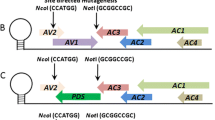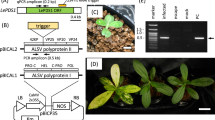Abstract
Coccinia grandis is an interesting model system to understand dioecy in Cucurbitaceae family. Recent transcriptomics and proteomics studies carried out to understand the sex expression in C. grandis have resulted in identification of many candidate sex-biased genes. In absence of an efficient genetic transformation protocol for C. grandis, virus-induced gene silencing (VIGS) would be a powerful tool to enable gene functional analysis. In current study, we explored the apple latent spherical virus (ALSV) for gene knockdown in C. grandis. The viral infection was achieved through mechanical inoculation of ALSV-infected Chenopodium quinoa leaf extract onto the cotyledons of C. grandis. ALSV-VIGS mediated knockdown of CgPDS gene was successfully achieved in C. grandis by mechanical inoculation method resulting in characteristic photobleaching. Subsequently, we developed agroinfiltration compatible vectors for direct infection of C. grandis and shortened the time-frame by skipping viral propagation in C. quinoa. Typical yellow-leaf phenotype was observed in C. grandis plants agroinfiltrated with ALSV-CgSU constructs, indicating robust silencing of CgSU gene. In addition, we improved the infection efficiency of ALSV by co-infiltration of P19 viral silencing suppressor. These results suggest that ALSV-VIGS is suitable for characterization of gene function in dioecious C. grandis and it can help us understand the mechanism of sex expression.





Similar content being viewed by others
Data Availability
All data generated or analysed during this study are included in this published article.
References
Al-Kaff, N. S., Covey, S. N., Kreike, M. M., Page, A. M., Pinder, R., & Dale, P. J. (1998). Transcriptional and post transcriptional plant gene silencing in response to a pathogen. Science,279, 2113.
Arnon, D. I. (1949). Copper enzymes in isolated chloroplasts. Polyphenoloxidase in Beta vulgaris. Plant Physiology,24, 1. https://doi.org/10.1104/pp.24.1.1.
Baulcombe, D. C. (1999). Fast forward genetics based on virus-induced gene silencing. Current Opinion in Plant Biology,2, 109–113. https://doi.org/10.1016/S1369-5266(99)80022-3.
Brigneti, G., Martín-Hernández, A. M., Jin, H., Chen, J., Baulcombe, D. C., Baker, B., et al. (2004). Virus-induced gene silencing in Solanum species. The Plant Journal,39, 264–272. https://doi.org/10.1111/j.1365-313X.2004.02122.x.
Bruun-Rasmussen, M., Madsen, C. T., Jessing, S., & Albrechtsen, M. (2007). Stability of barley stripe mosaic virus–induced gene silencing in barley. Molecular Plant-Microbe Interactions,20, 1323–1331. https://doi.org/10.1094/MPMI-20-11-1323.
Burch-Smith, T. M., Anderson, J. C., Martin, G. B., & Dinesh-Kumar, S. P. (2004). Applications and advantages of virus-induced gene silencing for gene function studies in plants. The Plant Journal,39, 734–746. https://doi.org/10.1111/j.1365-313X.2004.02158.x.
Burk, L., & Menser, H. A. (1964). A dominant aurea mutation in tobacco. Tobacco Science,8, 101–104.
Cai, X.-Z., Xu, Q.-F., Wang, C.-C., & Zheng, Z. (2006). Development of a Virus-induced gene-silencing system for functional analysis of the RPS2-dependent resistance signalling pathways in Arabidopsis. Plant Molecular Biology,62, 223–232. https://doi.org/10.1007/s11103-006-9016-z.
Cakir, C., & Tör, M. (2010). Factors influencing barley stripe mosaic virus-mediated gene silencing in wheat. Physiological and Molecular Plant Pathology,74, 246–253. https://doi.org/10.1016/j.pmpp.2010.04.001.
Chapman, S., Kavanagh, T., & Baulcombe, D. (1992). Potato virus X as a vector for gene expression in plants. The Plant Journal,2, 549–557. https://doi.org/10.1046/j.1365-313X.1992.t01-24-00999.x.
Covey, S. N., Al-Kaff, N. S., Lángara, A., & Turner, D. S. (1997). Plants combat infection by gene silencing. Nature,385, 781. https://doi.org/10.1038/385781a0.
Devani, R. S., Chirmade, T., Sinha, S., Bendahmane, A., Dholakia, B. B., Banerjee, A. K., et al. (2019). Flower bud proteome reveals modulation of sex-biased proteins potentially associated with sex expression and modification in dioecious Coccinia grandis. BMC Plant Biology,19, 330. https://doi.org/10.1186/s12870-019-1937-1.
Devani, R. S., Sinha, S., Banerjee, J., Sinha, R. K., Bendahmane, A., & Banerjee, A. K. (2017). De novo transcriptome assembly from flower buds of dioecious, gynomonoecious and chemically masculinized female Coccinia grandis reveals genes associated with sex expression and modification. BMC Plant Biology,17, 241. https://doi.org/10.1186/s12870-017-1187-z.
Ding, S.-W., & Voinnet, O. (2007). Antiviral immunity directed by small RNAs. Cell,130, 413–426. https://doi.org/10.1016/j.cell.2007.07.039.
Donaire, L., Barajas, D., Martínez-García, B., Martínez-Priego, L., Pagán, I., & Llave, C. (2008). Structural and genetic requirements for the biogenesis of tobacco rattle virus-derived small interfering RNAs. Journal of Virology,82, 5167–5177. https://doi.org/10.1128/jvi.00272-08.
Dong, Y., Burch-Smith, T. M., Liu, Y., Mamillapalli, P., & Dinesh-Kumar, S. P. (2007). A ligation-independent cloning tobacco rattle virus vector for high-throughput virus-induced gene silencing identifies roles for NbMADS4-1 and 2 in floral development. Plant Physiology,145, 1161.
Fu, D. Q., Zhu, B. Z., Zhu, H. L., Jiang, W. B., & Luo, Y. B. (2005). Virus-induced gene silencing in tomato fruit. The Plant Journal,43, 299–308. https://doi.org/10.1111/j.1365-313X.2005.02441.x.
Fujita, N., et al. (2019). Development of the VIGS system in the dioecious plant Silene latifolia. International Journal of Molecular Sciences. https://doi.org/10.3390/ijms20051031.
Igarashi, A., et al. (2009). Apple latent spherical virus vectors for reliable and effective virus-induced gene silencing among a broad range of plants including tobacco, tomato, Arabidopsis thaliana, cucurbits, and legumes. Virology,386, 407–416. https://doi.org/10.1016/j.virol.2009.01.039.
Kalantidis, K., Schumacher, H. T., Alexiadis, T., & Helm, J. M. (2008). RNA silencing movement in plants. Biology of the Cell,100, 13–26. https://doi.org/10.1042/BC20070079.
Kon, T., & Yoshikawa, N. (2014). Induction and maintenance of DNA methylation in plant promoter sequences by apple latent spherical virus-induced transcriptional gene silencing. Frontiers in Microbiology. https://doi.org/10.3389/fmicb.2014.00595.
Kumagai, M. H., Donson, J., Della-Cioppa, G., Harvey, D., Hanley, K., & Grill, L. K. (1995). Cytoplasmic inhibition of carotenoid biosynthesis with virus-derived RNA. Proceedings of the National Academy of Sciences.,92, 1679.
Liu, Y., Schiff, M., Marathe, R., & Dinesh-Kumar, S. P. (2002). Tobacco Rar1, EDS1 and NPR1/NIM1 like genes are required for N-mediated resistance to tobacco mosaic virus. The Plant Journal,30, 415–429. https://doi.org/10.1046/j.1365-313X.2002.01297.x.
Livak, K. J., & Schmittgen, T. D. (2001). Analysis of relative gene expression data using real-time quantitative PCR and the 2−ΔΔCT method. Methods,25, 402–408. https://doi.org/10.1006/meth.2001.1262.
Mohanty, J. N., Nayak, S., Jha, S., & Joshi, R. K. (2017). Transcriptome profiling of the floral buds and discovery of genes related to sex-differentiation in the dioecious cucurbit Coccinia grandis (L.) Voigt. Gene,626, 395–406. https://doi.org/10.1016/j.gene.2017.05.058.
Nguyen, L.V. (1995) Transposon tagging and isolation of the sulfur gene in tobacco (Nicotiana tabacum). PhD Thesis, North Carolina State University
Peele, C., et al. (2001). Silencing of a meristematic gene using geminivirus-derived vectors. The Plant Journal,27, 357–366. https://doi.org/10.1046/j.1365-313x.2001.01080.x.
Ratcliff, F., Harrison, B. D., & Baulcombe, D. C. (1997). A similarity between viral defense and gene silencing in plants. Science,276, 1558.
Ruiz, M. T., Voinnet, O., & Baulcombe, D. C. (1998). Initiation and maintenance of virus-induced gene silencing. The Plant Cell,10, 937.
Sasaki, S., Yamagishi, N., & Yoshikawa, N. (2011). Efficient virus-induced gene silencing in apple, pear and Japanese pear using Apple latent spherical virus vectors. Plant Methods,7, 15. https://doi.org/10.1186/1746-4811-7-15.
Senthil-Kumar, M., & Mysore, K. S. (2011). New dimensions for VIGS in plant functional genomics. Trends in Plant Science,16, 656–665. https://doi.org/10.1016/j.tplants.2011.08.006.
Senthil-Kumar, M., & Mysore, K. S. (2014). Tobacco rattle virus–based virus-induced gene silencing in Nicotiana benthamiana. Nature Protocols,9, 1549. https://doi.org/10.1038/nprot.2014.092.
Tao, X., & Zhou, X. (2008). Pathogenicity of a naturally occurring recombinant DNA satellite associated with tomato yellow leaf curl China virus. Journal of General Virology,89, 306–311. https://doi.org/10.1099/vir.0.83388-0.
Waterhouse, P. M., & Fusaro, A. F. (2006). Viruses face a double defense by plant small RNAs. Science,313, 54.
Wu, C., Jia, L., & Goggin, F. (2011). The reliability of virus-induced gene silencing experiments using tobacco rattle virus in tomato is influenced by the size of the vector control. Molecular Plant Pathology,12, 299–305. https://doi.org/10.1111/j.1364-3703.2010.00669.x.
Zhang, C., Bradshaw, J. D., Whitham, S. A., & Hill, J. H. (2010). The development of an efficient multipurpose bean pod mottle virus viral vector set for foreign gene expression and RNA silencing. Plant Physiology,153, 52.
Acknowledgements
We thank Prof. Yoshikawa, Iwate University, Japan for kindly providing us pEALSR1 and pEALSR2L5R5 vectors. We acknowledge Dr. P. V. Shivaprasad, NCBS, Bangalore for kindly providing us the pDGB3alpha2_35S:P19:Tnos vector. We thank Mr. Nitish Lahigude for maintaining C. grandis plants in the green house as well as in the field. We would also like to thank Mr. Shailendra Kushwaha, Ms. Shruti Kulshrestha and Ms. Diksha Kumari for their help with some of the vector construction in the current study.
Funding
R.S.D. acknowledges research fellowship obtained from CSIR, HRDG, New Delhi. Financial support from DBT, Govt. of India (Grant No-BT/PR16399/NER/95/125/2015), and Director, IISER Pune are thankfully acknowledged. Funding body was not involved in the design of the study; collection, analysis, interpretation of data and in writing the manuscript.
Author information
Authors and Affiliations
Contributions
RSD, AKB, and SS planned and designed the research. RSD, AK, SJ, and SA performed experiments and analysed the data. RSD and AKB wrote the manuscript. SS helped in critical discussion, interpretation of data and edited the manuscript. All authors have read and approved the final manuscript.
Corresponding author
Ethics declarations
Conflict of interest
The authors declare that they have no conflict of interest.
Ethical Approval
This article does not contain any studies with human participants performed by any of the authors.
Additional information
Publisher's Note
Springer Nature remains neutral with regard to jurisdictional claims in published maps and institutional affiliations.
Electronic supplementary material
Below is the link to the electronic supplementary material.
12033_2020_259_MOESM1_ESM.tif
Supplementary file1 Online Resource 1: Fig. S1 Chenopodium quinoa plants infected with ALSV infectious cDNA for viral propagation. Infected C. quinoa leaves are used as inocula for C. grandis infection. White arrows indicate the chlorotic spots characteristic of ALSV infection in C. quinoa leaves (TIF 1846 kb)
Supplementary file2 Online Resource 2: Movie S1 Infiltration of Agrobacterium suspensions harbouring ALSV vectors into the cotyledons of C. grandis seedlings for induction of virus induced gene silencing (MP4 39031 kb)
12033_2020_259_MOESM3_ESM.tif
Supplementary file3 Online Resource 3: Fig. S2 (A) ALSV-CgPDS-infected C. grandis plants, 12-weeks post-inoculation. (B) ALSV-CgSU-infected C. grandis plants, 16-weeks post-infiltration (TIF 1405 kb)
Rights and permissions
About this article
Cite this article
Devani, R.S., Kute, A., John, S. et al. Development of a Virus‐Induced Gene Silencing System for Dioecious Coccinia grandis. Mol Biotechnol 62, 412–422 (2020). https://doi.org/10.1007/s12033-020-00259-7
Accepted:
Published:
Issue Date:
DOI: https://doi.org/10.1007/s12033-020-00259-7




